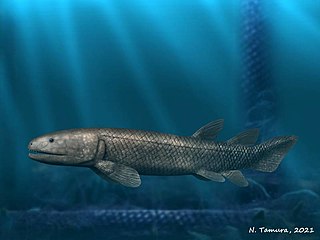
Megalichthyiformes is an extinct clade of basal tetrapodomorphs which first appeared during the Devonian period. It was named in 2010 by Michael I. Coates and Matt Friedman, who defined it as a stem-based taxon containing all tetrapodomorphs closer to Megalichthys than to Eusthenopteron.
Anthony's woodrat is an extinct subspecies of Bryant's woodrat in the family Cricetidae. It was found only on Isla Todos Santos in Baja California, Mexico. It is thought to have been driven to extinction through predation from feral cats.
Bryant's woodrat is a species of new-world rodent in the family Cricetidae native to the Southwestern United States and Mexico.
Bunker's woodrat is an extinct subspecies of Bryant's woodrat in the family Cricetidae. Only five specimens are known; these were collected in 1932 by W.H. Burt and are housed at a museum at UCLA. Neotoma bunkeri was only described from Coronados Islands, Baja California, Mexico. It probably died out as a result of depletion of food resources and predation by feral cats.
The San Martín Island woodrat is an extinct subspecies of Bryant's woodrat in the family Cricetidae.

A pack rat or packrat, also called a woodrat or trade rat, are any species in the North and Central American rodent genus Neotoma. Pack rats have a rat-like appearance, with long tails, large ears, and large, black eyes. Pack rats are noticeably larger than deer mice, harvest mice, and grasshopper mice, and are usually somewhat larger than cotton rats.
Zanclognatha jacchusalis bryanti is a moth of the family Noctuidae. It was described by William Barnes in 1928. It is found from British Columbia to Oregon.
Propalticidae is a family of beetles, in the suborder Polyphaga. It contains two genera with the following species:

Eotetrapodiformes is a clade of tetrapodomorphs including the four-limbed vertebrates and their closest finned relatives, two groups of stem tetrapods called tristichopterids and elpistostegalids.
Neocollyris bryanti is a species in the tiger beetle family Cicindelidae. It was described by Horn in 1922.

Gryllus bryanti is a species of cricket in the subfamily Gryllinae. G. bryanti lives on islands in the Caribbean Sea, including Eleuthera Island and Andros Island in the Bahamas.

Eupithecia bryanti is a moth in the family Geometridae first described by Taylor in 1906. It is found from Alaska, the Yukon Territory, Alberta and British Columbia, through Washington, Oregon, Montana, Idaho, Wyoming and Utah to California.

Pterolophia is a genus of longhorn beetles of the subfamily Lamiinae, containing the following species:
Dyschirius bryanti is a species of ground beetle in the subfamily Scaritinae. It was described by Kult in 1950.
Zelota bryanti is a species of beetle in the family Cerambycidae. It was described by Stephan von Breuning in 1938. It is known from Borneo.
Acmaeodera bryanti is a species of metallic wood-boring beetle in the family Buprestidae. It is found in North America.
Saropogon bryanti is a species of robber flies.
Colletes bryanti is a species of hymenopteran in the family Colletidae. It is found in North America.
Efferia bryanti is a species of robber flies in the family Asilidae.





